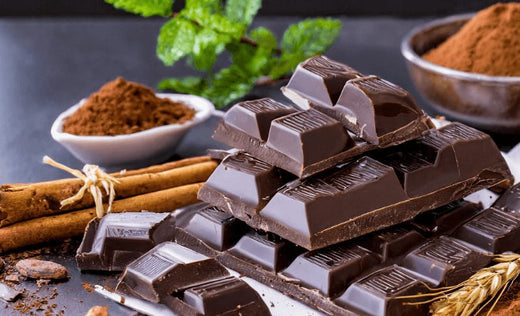In this post, we will explore the reasons behind the bitter flavour of dark chocolate, examining the roles of cocoa content, processing techniques, and the presence of certain chemical compounds.
Understanding these factors not only demystifies the taste of dark chocolate but also highlights the craftsmanship involved in creating this beloved treat.
Why is Dark Chocolate Bitter?
Dark chocolate is bitter due to its high concentration of cocoa solids.
Cocoa beans, the primary ingredient in dark chocolate, are naturally bitter.
The bitterness in cocoa beans comes from various compounds, including flavonoids, responsible for many of the health benefits associated with dark chocolate, such as antioxidant properties.
Unlike milk chocolate, which contains more sugar and milk solids to create a sweeter, creamier taste, dark chocolate has less sugar and may contain little to no milk.
The higher the percentage of cocoa in dark chocolate, the less room for sugar, making it inherently more bitter.
The processing of cocoa beans, including fermentation, roasting, and conching, can also influence the chocolate's bitterness and overall flavour profile.
Still, the fundamental bitterness is a characteristic feature of the cocoa itself.

How to Make Dark Chocolate Less Bitter
Making dark chocolate less bitter involves tweaking the ingredients and possibly adjusting the preparation process to soften its intense flavour.
While the characteristic bitterness of dark chocolate is cherished by many, there are ways to modify it for those who prefer a milder taste.
Here are several methods to reduce the bitterness in dark chocolate:
1. Add Sweeteners
Incorporating sweeteners can balance the bitterness of dark chocolate.
Sugar is the most common option, but you can also consider alternatives like honey, maple syrup, or sugar substitutes for a different flavour profile or to meet dietary needs.
The key is to add enough sweetener to counteract the bitterness without overwhelming the chocolate's rich flavour.
2. Use Milk or Cream
Adding milk or cream to dark chocolate can significantly reduce its bitterness.
The fats in milk or cream soften the intense flavours of the cocoa, creating a smoother and less bitter taste.
This method is especially effective when making hot chocolate or chocolate sauces.
3. Combine with Fats
Incorporating fats like butter or coconut oil into dark chocolate can also mellow its bitterness.
Fats can help distribute the flavour more evenly, reducing the intensity of the bitter compounds.
This approach is useful in recipes for chocolate ganache or truffles.
4. Mix with Other Flavours
Introducing additional flavours can help mask the bitterness of dark chocolate.
Vanilla extract is popular as it enhances sweetness and adds depth to the chocolate's flavour.
Cinnamon, cardamom, or chilli can also divert the palate from the bitterness, adding an intriguing complexity to the chocolate.
5. Choose a Lower Cocoa Percentage
Opting for dark chocolate with a lower cocoa percentage can naturally reduce bitterness if you're working with chocolate bars or chips.
Dark chocolates vary widely in cocoa content; those on the lower end (say, 50-70% cocoa) will be less bitter than those with higher percentages.
6. Conching
Though more relevant to chocolate makers than consumers, the process of conching, where chocolate is continuously mixed and aerated, can reduce bitterness.
Longer conching times can mellow the chocolate's flavour, making it smoother and less bitter.
This equates to choosing brands known for their smooth and mild dark chocolate at home.

Can You Learn to Enjoy Bitter Dark Chocolate?
To develop a taste for bitter dark chocolate, start with varieties with lower cocoa content and gradually increase the percentage.
Pairing dark chocolate with complementary flavours like nuts or fruit can help balance its bitterness.
Mindful tasting, where you savour the chocolate slowly, can enhance your appreciation for its complex flavours.
Learning about the chocolate-making process and experimenting with high-quality brands can also help you discover and enjoy the nuanced tastes of dark chocolate.
Over time, these steps can help you adjust to and appreciate dark chocolate's rich and complex profile.
How Does the % Affect the Bitterness of Dark Chocolate?
The percentage of cocoa in dark chocolate directly influences its bitterness: higher percentages mean more cocoa and less sugar, resulting in a bitter taste.
This increased cocoa content also brings out more complex flavours, such as fruity or nutty notes, and affects the chocolate's texture, making it less creamy.
The origin of the cocoa beans can further impact the bitterness and flavour profile, with beans from different regions offering unique tastes.
Thus, as the cocoa percentage rises, the chocolate becomes less sweet, more bitter, and potentially more complex in flavour.

Is Bitter Dark Chocolate More Healthy?
Bitter dark chocolate, with its higher cocoa content, is considered healthier due to its higher flavonoid content, which offers antioxidant and anti-inflammatory benefits.
It typically contains less sugar, which is beneficial for weight management and reducing the risk of diabetes and heart disease.
The flavonoids may also improve heart health, enhance blood flow, and improve cholesterol profiles.
Despite these benefits, consuming dark chocolate in moderation is important due to its calorie and fat content to avoid negating its health advantages.
Where Can You Buy Tasty Chocolate?
Whitakers Chocolates, renowned for our long history in crafting delicious and affordable chocolates, offers a range of options suitable for everyone, including vegetarian, vegan, and gluten-free choices.
Our top-selling products, such as indulgent Coffee Creams, Neapolitans, Chocolate Wafer Thins, Stem Ginger and Luxury Chocolate Truffles, are perfect for enhancing your mocha coffee experience.
Click here to see our full range of delicious chocolates…
Some Notes From an Expert Chocolatier
I've learned that the beauty of chocolate lies in its diversity.
Crafting chocolates of different strengths is essential to accommodate chocolate enthusiasts' broad spectrum of taste preferences.
Some individuals relish the bold, intricate flavours of high cocoa dark chocolate, valuing its purity and the depth it brings.
Others prefer the gentler, creamier notes of milk chocolate, where the cocoa's bitterness is harmoniously balanced with sweetness.
This variety caters to different palates and invites chocolate lovers to explore and expand their taste horizons.
It's about offering an inclusive chocolate experience, ensuring something for everyone.
Creating these varying strengths is a nuanced art as a chocolatier, balancing cocoa content and ingredients to craft chocolates that resonate with each individual's unique preferences.
Final Notes On Bitter Dark Chocolate
Bitter dark chocolate holds a distinctive place in the confectionery world, celebrated for its depth of flavour and myriad health benefits.
The bitterness, a natural characteristic derived from the cocoa solids, is not merely a taste to be acquired but a complex sensation that offers a deeper appreciation for chocolate in its most unadulterated form.
This intensity of flavour, appealing to many chocolate aficionados, also indicates the high levels of flavonoids and antioxidants present, contributing to the chocolate's health-enhancing properties.
Understanding and appreciating the nuances of bitter dark chocolate is a journey.
This journey not only tantalizes the taste buds but also contributes positively to well-being when enjoyed in moderation.
Whether you're a connoisseur or a casual enthusiast, dark chocolate offers a rich field for exploration, appreciation, and enjoyment.











